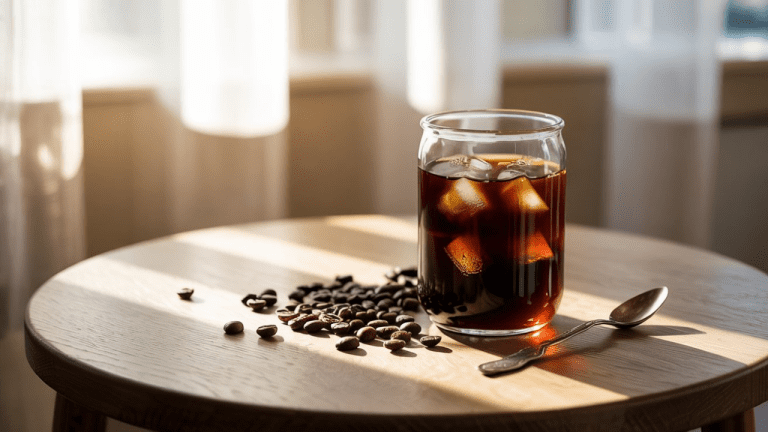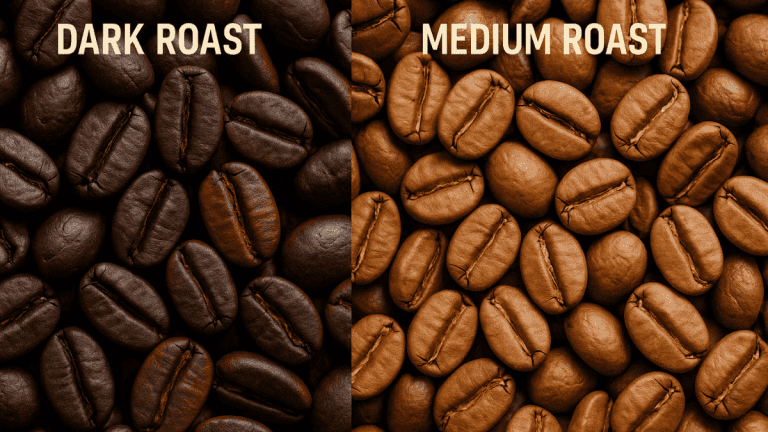
Standing in line at your favorite coffee shop, staring at the menu board, you might wonder about the differences between popular drinks. The Americano vs latte debate is one that many coffee drinkers face daily. Both beverages start with the same espresso foundation, yet they deliver completely different experiences in your cup. Whether you’re trying to decide what to order next or simply want to understand these coffee staples better, you’ll discover everything you need to know about how these two drinks compare. From taste and preparation to calories and customization options, this guide will help you make the perfect choice for your coffee preferences.
A side-by-side visual comparison of an Americano and a latte.
What is an Americano Coffee
An americano is essentially espresso diluted with hot water, creating a drink that resembles regular drip coffee but maintains the distinct characteristics of espresso. This straightforward beverage originated during World War II when American soldiers stationed in Italy found the local espresso too intense for their taste. They began adding hot water to their espresso shots, creating what locals called “americano” – “American” in Italian.
A hand pours hot water into a cup of espresso to create an Americano.
The preparation of an Americano is refreshingly simple: baristas pull one or two espresso shots directly into a cup, then add hot water in a typical 1:2 to 1:4 ratio. A standard 12-ounce americano contains about 2 ounces of espresso, topped with 10 ounces of hot water. The result is a bold, robust coffee with a thin consistency that appeals to those who appreciate intense, unadulterated coffee flavors. Unlike regular drip coffee, an americano retains the complex flavor notes and slight bitterness from the espresso extraction.
A clear mug of black coffee, likely an Americano, is on a glass saucer with a wooden spoon.
Understanding Latte Coffee Drinks
A latte represents the creamy, milk-forward side of espresso-based beverages. The name comes from the Italian “caffè latte,” meaning “milk coffee”. This popular drink combines espresso with steamed milk and features a thin layer of microfoam, creating the perfect canvas for latte art.
A barista steams milk with an espresso machine for a latte.
The magic of a latte lies in its milk preparation technique, a process that requires skill and finesse. Baristas steam milk to approximately 150-160°F, creating a velvety texture that blends seamlessly with espresso. A 12-ounce latte contains 1-2 espresso shots with 6-8 ounces of steamed milk. Steaming transforms regular milk into a creamy, sweet complement that mutes the espresso’s intensity. This makes lattes an excellent choice for those who enjoy coffee but prefer a milder, smoother taste experience.
Americano vs Latte Key Differences Explained
The core distinction between an Americano and a latte lies in their second ingredient: water versus milk. An Americano combines espresso with hot water, while a latte blends espresso with steamed milk. This fundamental difference creates dramatically different drinking experiences, from appearance to mouthfeel.
Here is a comparison of espresso, americano, cappuccino, and latte, showing their ingredients, volume, taste, and strength.
Visually, you can instantly distinguish these drinks. An americano appears dark and black, similar to regular coffee, often with a thin layer of crema on top. Due to the milk content, a latte presents a lighter, caramel-colored appearance, frequently topped with artistic foam designs. The preparation methods also differ significantly in complexity. Making an americano requires adding water to espresso, while crafting a latte requires skilled milk steaming techniques.
The texture contrast between an Americano and a latte is immediately noticeable. Americanos have a thin, watery consistency reminiscent of drip coffee, while lattes offer a rich, velvety mouthfeel. Temperature retention also varies—the milk in lattes helps maintain warmth longer than the water in Americanos.
Taste Profile and Flavor Comparison
The flavor profiles of Americano and Caffè Americano couldn’t be more different. Americano has bold, robust coffee flavors with slight bitterness and acidity. Since water doesn’t mask the espresso’s natural characteristics, you’ll taste all the complex notes from your coffee beans. The drink maintains the espresso’s intensity while providing more volume than a straight shot.
Lattes offer a completely different tasting experience. The steamed milk adds natural sweetness and creaminess that mellows the espresso’s sharp edges. Many describe lattes as smooth, mild, and approachable, making them perfect for those who find straight espresso too intense. The milk’s proteins and fats create a balanced flavor that highlights coffee’s sweeter notes while reducing perceived bitterness.
Your taste preferences will largely determine which drink appeals to you more. An americano suits your palate if you enjoy strong, black coffee and appreciate tasting the full coffee flavors. Those who prefer creamier, milder beverages with subtle coffee notes will likely gravitate toward lattes. The best occasions to enjoy an americano are when you need a quick caffeine boost or want to savor the full flavor of your coffee beans. On the other hand, lattes are perfect for leisurely mornings or when you want a comforting, creamy drink.
Caffeine Content in Americano vs Latte
Surprisingly, the difference in caffeine content between Americano and a is minimal. Both drinks typically contain the same number of espresso shots, making their caffeine levels nearly identical. A 12-ounce serving of either drink with two espresso shots contains approximately 136-154mg of caffeine.
The perception of strength differs dramatically between these beverages. An americano may feel stronger due to its bold, undiluted coffee flavor, while a latte’s milk content masks the caffeine sensation. Some coffee shops add an extra shot to larger Americanos, potentially increasing the caffeine content to 231mg in 20-ounce servings.
Individual caffeine sensitivity varies, but neither Americano nor Espresso provides significantly more stimulation than the other. The delivery method differs—Americanos give a more immediate caffeine hit due to their concentrated flavor, while lattes deliver caffeine more gradually through the milk buffer. This immediate caffeine hit from an Americano can be invigorating, making it a popular choice for those who need a quick pick-me-up.
Calorie and Nutrition Facts Comparison
The nutritional difference between an Americano and a latte is substantial. An Americano contains virtually no calories—typically just 5-10 calories per 12-ounce serving. Since it’s essentially espresso and water, it provides no significant nutrients or unwanted additives.
Lattes tell a different story nutritionally. A 12-ounce latte with whole milk contains approximately 190 calories, 11 grams of fat, and 14 grams of sugar. However, lattes also provide beneficial nutrients from milk, including 11 grams of protein, calcium for bone health, and various vitamins. Choosing different milk types can alter these numbers – 2% milk reduces calories to about 150, while oat milk alternatives may increase calories to 200.
Americanos clearly win the Americano vs. latte comparison for those watching their caloric intake. However, if you’re looking for a more substantial beverage that provides nutrients and satiety, lattes offer nutritional value beyond just caffeine.
How to Make Americano and Latte at Home
Creating an Americano at home requires minimal equipment and technique. You’ll need an espresso machine or an alternative brewing method like a Moka pot. Add 1-2 shots of espresso to your cup, then 6-8 ounces of hot water. The standard ratio is 1:4 (espresso to water), but you can adjust to taste. Some prefer adding water first to preserve the crema layer.
Making lattes at home demands more skill and equipment. Beyond espresso capability, you’ll need milk steaming equipment. Pour 4-6 ounces of cold milk into a steaming pitcher, ensuring it doesn’t exceed halfway up the spout. Steam the milk to 150-160°F while creating microfoam by keeping the steam wand tip below the surface. Pour the steamed milk over your espresso shot, finishing with a thin foam layer.
Common mistakes when making Americanos vs. lattes at home include using too much water in Americanos (diluting the flavor) and overheating milk in lattes (creating a scalded taste). Practice makes perfect for both beverages, though Americanos are significantly more forgiving for beginners.
Which Coffee Should You Choose
Choosing between an Americano and a latte depends entirely on your preferences and circumstances. Select an Americano if you enjoy intense, bold coffee flavors and want a low-calorie option. This drink suits those who appreciate tasting the nuances of different coffee beans and prefer their beverages without milk.
Opt for a latte if you prefer creamy, mild coffee drinks or are new to espresso-based beverages. Lattes work well for those who find straight coffee too bitter or intense. They’re also ideal for a more substantial drink with caffeine and nutrients.
Consider timing and context, too. Americanos work well as morning wake-up calls or afternoon pick-me-ups when you want pure coffee flavor. Lattes make excellent comfort drinks or social beverages when you want something more indulgent. Both drinks offer customization opportunities, though lattes provide more flavor addition possibilities.
Popular Variations and Customization Options
Both Americano and latte offer numerous customization possibilities. Americano variations include the Long Black (water added first), Italiano (1:1 ratio), and iced versions for warmer weather. You can add milk or cream to create a “White Americano.”
Latte customization options are virtually limitless. Popular syrup flavors include vanilla, caramel, hazelnut, and seasonal options like pumpkin spice. Different milk alternatives create unique flavor profiles – oat milk adds natural sweetness, almond milk provides nuttiness, and coconut milk offers tropical notes. Iced lattes, flavored variations, and different milk-to-espresso ratios create distinct experiences.
Seasonal modifications keep both drinks enjoyable year-round. Summer calls for iced versions, while winter invites warming spices and holiday flavors. Many coffee shops offer specialty versions that showcase local ingredients or unique preparation methods.
Best Coffee Bean Recommendations
The Americano vs. latte comparison extends to optimal bean selection. Americanos prominently showcase coffee characteristics, making bean choice crucial. Medium to dark roasts work well, providing body and reducing excessive acidity. Single-origin beans let you taste specific regional characteristics, while blends offer balanced complexity.
Lattes benefit from different bean profiles. Since milk mellows sharp flavors, lighter roasts that might seem too acidic in Americanos can be used. Chocolatey, nutty, or caramel-noted coffees complement milk beautifully. Darker roasts provide robust flavors that won’t disappear under steamed milk.
Quality matters more than the specific origin of Americanos and lattes. Fresh roasting dates ensures optimal flavor extraction, while proper grinding just before brewing maximizes taste potential. Experiment with different origins and roast levels to find your preferred profile for each drink style.
Final Recommendations
Your choice between an Americano and a latte ultimately comes down to personal taste, dietary goals, and coffee experience level. Both beverages offer unique pleasures and serve different purposes in your coffee routine. Americanos provide pure, unadulterated coffee enjoyment with minimal calories, while lattes offer creamy comfort with nutritional benefits.
Don’t limit yourself to just one choice. Many coffee enthusiasts enjoy Americano and latte, depending on mood, time of day, or specific cravings. Start with whichever sounds more appealing, then gradually explore the other option to expand your coffee palate. Both drinks offer excellent entry points into espresso-based beverages and provide countless customization opportunities to match your evolving tastes.






